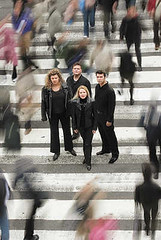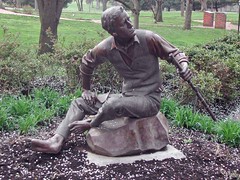Ethel--a band not a string quartet
The four virtuosic string players who conceived the ensemble Ethel, named their band in such a way that it would never be confused with a traditional string quartet, even though the ensemble's instrumentation is exactly that--two violins, viola, and cello. This is not your mother's Haydn Quartet, this is not your father's string chamber ensemble.
On a recent visit to Lexington, Kentucky on their nascent "Truck Stop" tour, Ethel wallowed in the delights of traditional Kentucky musical culture, singing and playing along with the Appalachian Association of Sacred Harp Singers, a group of old time musicians that meets weekly on Thursday evenings to share tales and tunes under the blue moon of Kentucky, the Red State Ramblers, and other groups including Rowan County's Clack Mountain and bluegrass musicians, including Dean Osborn and Tim Lake.
The joys of this collaboration and conspiracy were lived in the vivid musical encounters--sharing the linear open harmonies of venerable shape note hymnody with singers in the Gallery of the John Jacob Niles Center for American Music, or sharing fiddle tunes, moonlight and moonshine, and exuberant conversations late into the early hours on a farm in the Kentucky River palisades. There was a simply magical moment after a hard-driving dance tune--it might have been "Indian Ate the Woodchuck"--cellist Dorothy Lawson gently slid into a meditative Bach unacompanied cello suite movement that created a reverie, a moment of absolute transcendent peace. Fiddle and Violin were at one in harmony.
The collaborative musical experiences culminated in several public events, including a "Best of the Bluegrass" concert at Lexington's Opera House on April 11, 2007--but this was more opry than opera with the rarified string quartet instrumentation of Ethel metamorphicized into a virtuosic rollicking stringband to complement the old time and bluegrass musicians swirling about them.
Kentucky has long displayed a schizophrenic relationship to its traditional cultural heritage. The Commonwealth fears being saddled with the sterotypes associated with "hillbilly" heritage, and yet it longs to be recognized for its remarkable mountain heritage of traditional and bluegrass music. Sometimes it takes a group from New York to make us realize what "Best of the Bluegrass" really means. Sometimes it takes innovative partners like Ethel, to refashion our tarnished old wedding band into a gem sparkling in a new platinum setting.
Welcome back to your new Old Kentucky Home anytime, Ethel....



